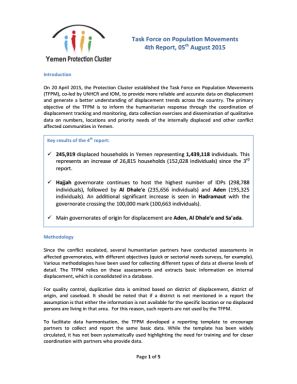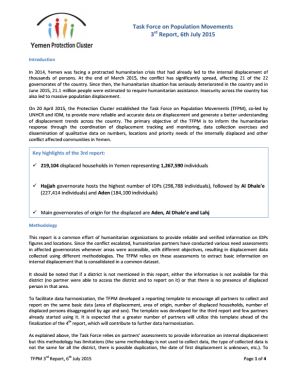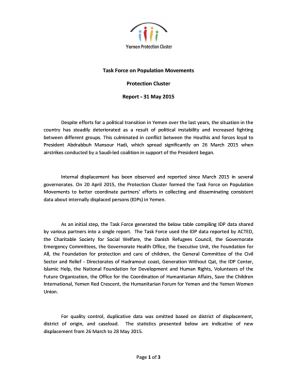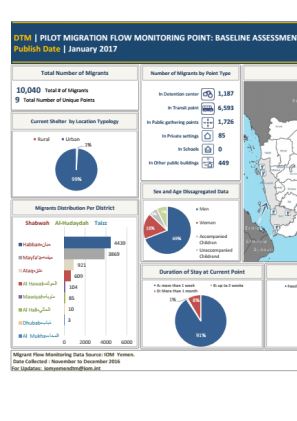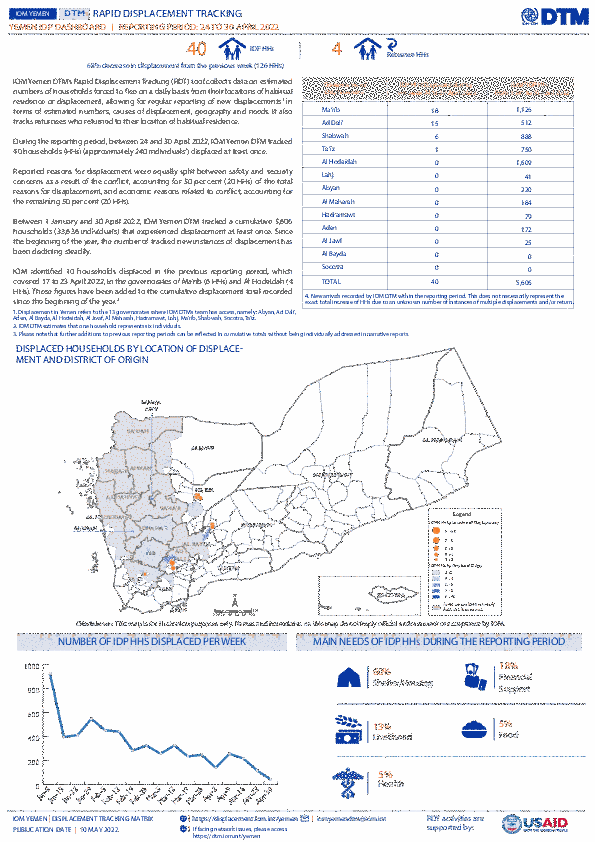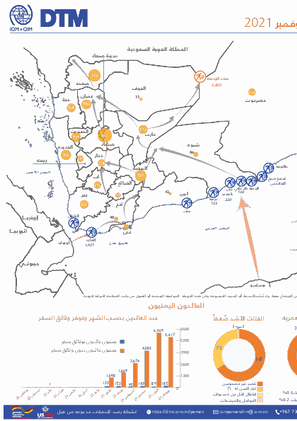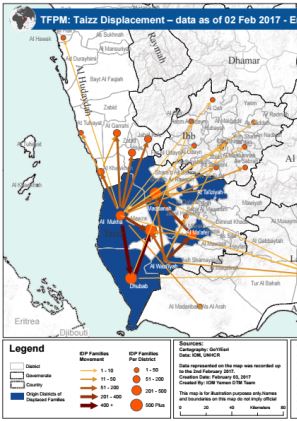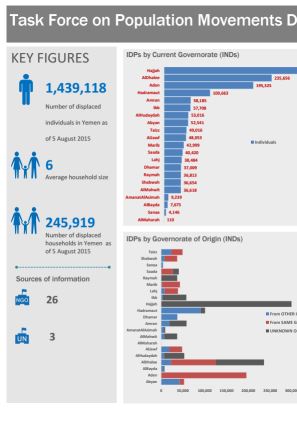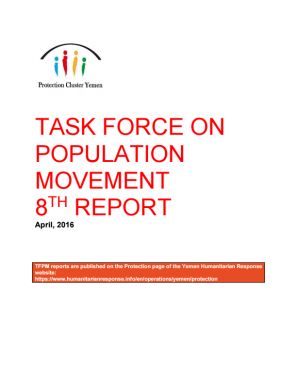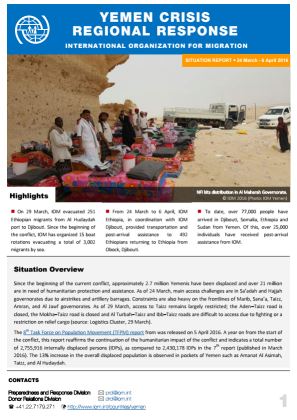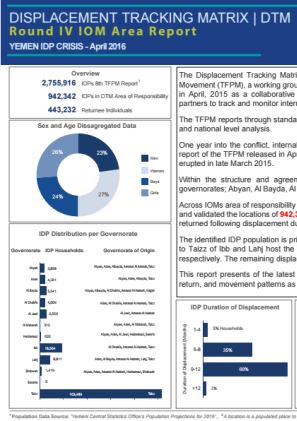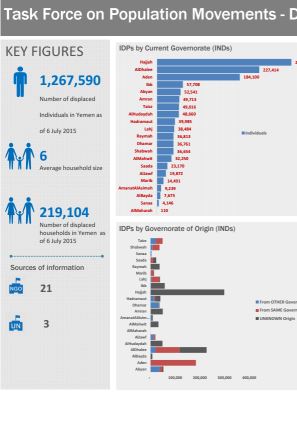-
Countries
-
Data and Analysis
-
Special Focus
-
Crisis Responses
Yemen
IDPs tracked
Displacement Movements
4,516,000
IDMC 2023
Data collection round
About Yemen
Overview
The situation in Yemen has steadily deteriorated as a result of instability and increased fighting between multiple groups. Large scale internal displacement has been observed across the country since the conflict started in 2015. IOM Yemen’s DTM was launched the same year in an effort to better inform the humanitarian community about the location and needs of displaced populations. The DTM identifies both IDP and returnee locations and tracks displacement trends on a daily basis. The DTM also monitors key migrant arrivals and the return of Yemeni migrants mainly in locations across Yemen’s southern coastal border and northern border with the Kingdom of Saudi Arabia (KSA).
Rapid Displacement Tracking (RDT)
As part of the DTM’s mobility tracking, Rapid Displacement Tracking (RDT) primarily tracks IDP and returnee populations throughout Yemen. Information on areas of displacement and return, origins and reasons for displacement, shelter types, and priority needs are collected on a daily basis. RDT data is not representative of all displacements occurring in Yemen due to access constraints in many governorates.
Area Assessment (AA)
The Area Assessment collects stock figures on the number of IDPs, returnees, and migrants, as well as the origins, reasons for displacement, shelter types, and the situation overview at a target location. The Area Assessment data is collected through an extensive key informant network at the smallest geographical area that is operationally possible. This assessment is used to verify and update the baseline information in quarterly cycles, with field staff revisiting and updating information on all previously identified locations populated by IDP and returnee populations.
Flow Monitoring Registry (FMR)
The DTM’s Flow Monitoring Registry (FMR) monitors key third-country migrant arrivals and departures mainly in locations across Yemen’s southern coastal border as well as key Yemeni returns on the northern border with the KSA. Enumerators placed at Flow Monitoring Points (FMPs) record arrivals of migrants and returning Yemeni nationals in order to identify different patterns and types of migration, and to provide quantitative estimates to help define the population of irregular migrants entering the country. FMR is not representative of all flows in Yemen and should be understood only as indicative of the individuals recorded at FMPs during the timeframe indicated. Access constraints limit the ability to collect data at some migrant arrival points.
Multi-Cluster Location Assessment (MCLA)
In order to carry out an evidenced-based needs analysis for the Humanitarian Needs Overview (HNO), and to allow humanitarian partners to make planning decisions, the Yemen Inter-Cluster Coordination Mechanism (ICCM) proposed to carry out a Multi-Cluster Location Assessment (MCLA). This also involves the Technical Working Group (TWG) to formulate planning and implementation processes, as well as data examination and compilation. This assessment is based on the MCLA tool that has been used to assess IDP needs in previous years but has been broadened to include all key population groups that are in need of humanitarian assistance according to the previous HNO. The MCLA will provide nationwide data and evidence-based findings for the HNO to better inform the Humanitarian Response Plan (HRP) in Yemen.
Contact
Current Donors
- Canada
- ECHO
- GFFO
- BHA
Yemen — TFPM Report 4 (7 July — 5 August 2015)
As of 5 August 2015, the TFPM has identified 1,439,118 internally displaced persons (IDPs) (245,919 households) in Yemen. Hajjah governorate continues to host the highest number of IDPs (298,788 individuals), followed by Al Dhale'e (235,656 individuals) and Aden (195,325 individuals).
Aug 05 2015
Yemen — TFPM Report 4 (7 July — 5 August 2015)
Yemen — TFPM Report 3 (30 June — 6 July 2015)
As of 31 May 2015, the TFPM has identified 1,267,590 internally displaced persons (IDPs) (219,104 households) in Yemen. Hajjah governorate hosts the highes number hosting of IDPs, with 298,788 displaced persons, followed by Al Dhale’e with 227,414 IDPs.
Jul 06 2015
Yemen — TFPM Report 3 (30 June — 6 July 2015)
Yemen — TFPM Report 2 (26 March — 31 May 2015)
As of 31 May 2015, the TFPM has identified 1,019,762 internally displaced persons (IDPs) (158,887 households) in Yemen.
Jun 01 2015
Yemen — TFPM Report 2 (26 March — 31 May 2015)
Yemen – Pilot Migration Flow Monitoring Point: Baseline Assessment (January 2017)
10,040 migrants were recorded across 9 flow monitoring points. 1,187 were recorded in detention centers, 6,593 at transit points, 1,726 at public gathering points, 85 in private settings and 449 in other public buildings.
Yemen — TFPM Report 11 (October 2016)
In connection with the ongoing conflict, 2,179,278 internally displaced persons (IDPs) who remain in a situation of displacement across 21 governorates; the majority, 51%, are displaced in Hajjah, Taizz, and Sana’a.
Yemen — Rapid Displacement Tracking Update (24 April - 30 April 2022)
IOM Yemen DTM’s Rapid Displacement Tracking (RDT) tool collects data on estimated numbers of households forced to flee on a daily basis from their locations of origin or displacement, allowing for regular reporting of new displacements in terms of estimated numbers, geogra
اليمن_ نقاط تتبع التدفق | المهاجرون الوافدون واليمنيون العائدون في نوفمبر 2021
تعمل مصفوفة تتبُع النزوح الخاصة بالمنظمة الدولية للهجرة في اليمن على مراقبة المواقع الرئيسية التي يصل عبرها المهاجرون على الحدود الساحلية الجنوبية، و مواقع العائدون اليمنيون والموجودة على الحدود الشمالية لليمن مع المملكة العربية السعودي
Yemen – TFPM: Taizz Displacement (2 February 2017)
A map indicating the movements of IDP families from and within: Al Mukha, Maqbanah, At Ta'iziyan, Al Ma'afer, Al Wazi'iyah and Dhubab districts.
Yemen — TFPM Report Dashboard 4 (5 August 2015)
As of 5 August 2015 1,439,118 IDPs comprising 245,919 households were identified. The Hajja governorate hosted the highest number of IDPs, 298,788.
Yemen — TFPM Report 8 (March 2016)
An increase of 325,738 IDPs (13%) was noted from the 7th report. While further displacement decreased in the south, it continued to be documented in the north.
Yemen – Regional Response (24 March 2016)
As of 24 March 2016 IOM has assisted 53,706 IDPs in Abyan, Aden, Al Dhale’e, Hadhramaut, Lahj, Al Mahrah, Sa’adah, Shabwah, Socotra and Taizz governorates through shelter and NFI support. 13,684 vulnerable migrants were provided with health assistance in migrant-concentrated areas and b
Yemen — TFPM Report 9 (April 2016)
As of April 2016 942,342 individuals comprising 157,057 households were recorded in the IOM area of responsibility. This is an area comprised of 12 governorates: Abyan, Al Bayda, Al Mahara, Aden, Al Dhale’e, Al Jawf, Hadramaut, Ibb, Lahj, Shabwah, Socotra and Taizz.
Yemen — TFPM Report Dashboard 3 (6 July 2015)
As of 6 July 2015 1,267,590 IDPs comprising 219,104 were identified in Yemen. These dashboards show the spread of these IDPs across 21 governorates and indicate the numbers of IDPs displaced within and outside their governorates of origin.
Pagination
- First page
- Previous page
- …
- 16
- 17
- 18
- 19
- 20
- 21
- 22
- 23
- 24
Pagination
- First page
- Previous page
- …
- 8
- 9
- 10
- 11
- 12
- 13
- 14
- 15
- 16


